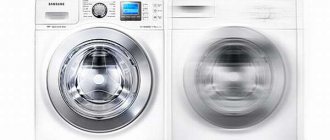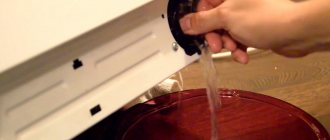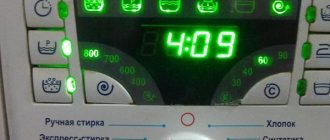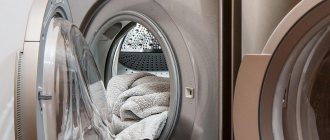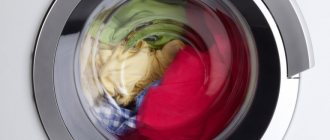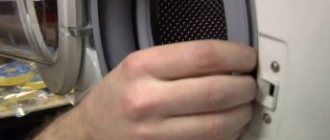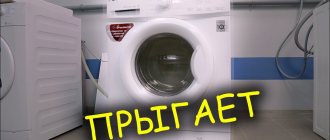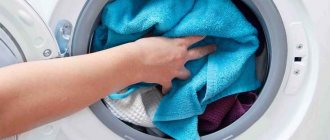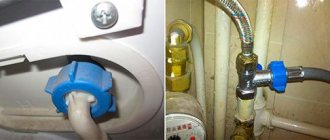Published: 20 Dec 2020
You threw things into the washing machine, turned on the wash and forgot about it for a while, because the automatic equipment does not require attention until the end of the work. But this time, when you went to the washing machine to take out and hang up the clean clothes, you discovered that the washing machine had frozen.
The washing machine can stop at any time, both at the beginning and at the end of the wash; it can stop during rinsing or when it starts spinning. In most cases, equipment owners turn to us for help when the SMA freezes during the spin cycle.
Weight restrictions
Each washing machine has certain characteristics. However, there are weight restrictions. The technique allows you to wash from 4 to 6 kilograms of laundry at a time. This indicator depends on the model. If you exceed the recommended weight, the device may break. It is for this reason that many manufacturers install protection systems. They work when overloaded. As a result, the washing machine stops.
To avoid such situations, you should carefully study the manufacturer's instructions and recommendations. Do not exceed the weight specified in the documents. For the device to work, you need:
- Drain the water.
- Turn off power.
- Remove some of the contents from the drum.
See also –
Washing machine does not go into rinse mode
Reasons for stopping
Weight restrictions
If during the washing process or in the “spin” mode the machine stops or the rotation of the drum slows down, this means that the machine is overloaded. In this case, you must urgently drain the water and remove some of the laundry.
If the hatch is blocked and the laundry cannot be pulled out, you need to turn off the machine with the “on-off” button and unplug the plug from the socket. After 5-10 minutes the hatch will unlock itself. Wait until the motor has cooled down (another 20 minutes) before resuming washing.
Overloading the washing machine has a negative impact on its service life and the quality of the wash. When overloaded, the motor overheats and parts wear out. If the load is excessive, the machine cannot rinse the laundry properly.
Do not put too few items into the washing machine, the weight of which is lower than that recommended by the manufacturer. In this case, when spinning, the machine will vibrate and make a lot of noise. Failure to follow operating instructions can lead to breakdowns.
Unbalanced laundry in the washing machine
Pre-sorting laundry is a very useful habit for those who want to do quality laundry. If you load laundry of different weights and composition into the drum, there is a risk of an imbalance of the laundry in the drum. Bulk heavy things will crumple and outweigh the light ones.
Most often, such problems arise in the “spin” mode. The machine will begin to shake and the drum will slow down.
If the manufacturer provides an “imbalance control” function, the machine will rotate the drum in different directions at different speeds. However, if the imbalance still does not disappear, the machine will not spin. After the wash program has completed and the door is unlocked, the laundry will remain wet.
If the wash has stopped due to imbalance, you can redistribute the items in the drum manually.
To do this, wait until the hatch is unlocked or forcefully press the power button, drain the water and disconnect the machine from the power supply. When the hatch is unlocked, distribute the items evenly inside the drum and continue washing.
The only thing that can save you from imbalance is pre-sorting the laundry.
Clogged water supply or drainage system
The most common mistake when drawing water is a clogged inlet filter. It can be cleaned manually or replaced. The water supply valve may also break or there may be problems with the electronics (for example, with the water level sensor, with the hatch closing sensor or (the most expensive) with the control module).
If there is no drain, first check that the drain filter is not clogged. You can unscrew it yourself and clean it under strong water pressure. To do this, you need to remove the decorative panel at the bottom of the machine facade and unscrew the filter. Just in case, be on the safe side - prepare a container for emergency drainage of water if water remains in the car.
If the problem persists, the cause may be the pump (drain pump), as well as failure of the electronics.
Before calling a technician, make sure there are no external causes of the malfunction.
The problem may be that the water supply pressure is too weak or that the drain hose is bent on the outside.
Malfunction of the heating element (heating element)
Diagnosing this problem is very simple - the quality of washing has decreased, the machine began to wash without heating the water.
The heating element fails for a number of reasons: there is a current leak (the RCD is triggered), the heating filament has broken, or a banal scale has formed due to hard water.
You can fight scale by installing special water filters. You can also periodically clean the heating element.
Sensor malfunctions
The more electronics there are in a car, the more difficult it is to find and fix a fault. If the sensors fail, the washing machine turns off during washing, problems arise with the supply and heating of water, and with the rotation of the drum.
Main sensors:
- pressure switch (controls the water level in the tank, protects against tank overfilling, and if there is a malfunction, issues an error code),
- temperature (when heated to a certain temperature, it turns off the heating element, protects against overheating, and replaces it if it breaks),
- tachometer (Hall sensor) (if it breaks, the “spin” stops working, the drum speed does not correspond to the specified parameters, an error code appears on the display),
- motor overheat protection sensor (turns off power in case of heavy load),
- emergency (overflow protection),
- auto-weighing (protection against overload and underload of laundry),
- aquasensor (signals about the supply of dirty water).
Problems with the electronic control unit
The control unit completely controls the operation of the machine. It processes signals from sensors, starts operating modes, and is responsible for blocking in case of a malfunction. If it breaks down, the machine turns on with an error.
It fails for the following reasons:
- manufacturing defect (discovered during the warranty period and repaired under warranty),
- voltage drops (installing a voltage stabilizer in the apartment will help),
- malfunction of the sensors (they need to be replaced),
- water or debris getting into the unit (if there is no factory sealing, you need to carefully wipe the body).
Broken hatch door
The result of mechanical damage (for example, a stuck latch or a broken hinge) or an electronic failure.
Determining the nature of the damage is quite simple. If there is no characteristic click when closing the hatch, then the problem is with physical wear of the parts, misalignment of the door or the “tongue” in the lock. To fix this problem, you can start by checking the level of the door and, if it is misaligned, adjust the fasteners using a screwdriver. If this does not help, the door will have to be disassembled, the hinges and the hatch handle can be changed.
If the sunroof does not lock when there is a click, it indicates either a malfunction of the sunroof lock sensor or problems in the control unit. Only a specialist can fix this problem.
Leakage protection system activated
Occurs when the rubber seal of the hatch or the pipes inside the car (most often the “drain”) are damaged.
It is necessary to turn off the water supply tap, disconnect the machine from the electricity, take out the laundry, and drain the water. It is imperative to find the leak. You can do this yourself or call a specialist. By the way, after turning on the machine again after 10-15 minutes, the error may disappear. This means that these are sensor errors.
Water entering the pan
The problem is associated either with a leaky hose or with a malfunction of the leakage sensor (AquoStop system). You need to drain the water, take out the laundry, disconnect the machine from the power supply and visually look for the problem. If it is visible, try restarting the wash. If the error does not disappear, call a technician immediately.
Unbalanced laundry in the washing machine
Why does the washing machine stop during washing? There are many reasons for this. The washing machine does not necessarily turn off due to a breakdown. Perhaps the protection is triggered. Some models have sensors that are triggered when there is an imbalance. This phenomenon occurs when laundry accumulates on one side of the drum. This causes strong vibration. An imbalance is no less dangerous for a washing machine than an overload.
To avoid strong vibration, you should carefully fold the laundry inside the appliance. If the washing machine stops during operation, you should:
- Drain the water.
- Turn off power.
- Evenly distribute the contents of the drum.
Minor problems
The fact that the washing machine turns off during washing may have several unimportant reasons that can be easily eliminated. However, they are often difficult to detect because their manifestations are not always obvious.
Drum overload
The most common reason that the device turns off a short time after pressing the “start” button is that the user has put too many things. Each model has a maximum weight that must not be exceeded. Please note that it is indicated for cotton clothing. If you plan to wash woolen items, you cannot add the same amount of laundry. It should be reduced, because such fabrics absorb much more water.
The washing machine may shut down due to the drum being overloaded due to imbalance, even if the weight is not exceeded. If you plan to wash 1-2 heavy items, they need to be carefully straightened. You can’t put them in a “clump”.
Problems with electricity or water supply
The fact that the machine stopped working during washing may have reasons not directly related to the device. This situation is possible if the water supply was cut off or the electricity was cut off.
In a situation where there has been no water for several minutes, the cycle will spontaneously start. If more time has passed, then after the problem is resolved, the user must press the device start button again. It will drain the water from the drum and start the cycle again.
Even if the user did not notice that the power was turned off or there were interruptions in the water supply, he should try to start the machine again. This situation may have been short-lived, but led to a work stoppage.
Wrong program selection
On models that offer a large number of programs and additional washing parameters, situations are possible when the user sets an incompatible combination of functions.
For example, some washing machines may turn off when the prewash and bleach modes are selected.
This will not happen immediately after startup, but when the first stage of the cycle is completed and the device proceeds to the next operation, which contradicts the previous one.
Error in the selected washing program
It happens that the owners of a washing machine, without any intention, turn on the delicate wash mode, expecting that the machine will rinse and spin the laundry.
But this program does not imply such a function and there is no problem as such.
If the washing machine stops rinsing, in this case you can forcefully drain the water by turning on the “drain” mode, and then use the “spin” program.
A similar story happens when the “Soaking – Washing – Bleaching” program is selected, because not a single washing machine will allow you to run soaking and bleaching at the same time.
The operating instructions contain a lot of information, including always describing the programs and their features.
This booklet should be at hand so that such misunderstandings do not arise.
Clogged water supply or drainage system
If the device stops working in the “Rinse” or “Spin” mode, then the cause of the malfunction lies in a blockage in the system that drains or supplies water. In such situations, protection also works. As a result, the drum stops rotating.
A blockage often occurs in the hose designed to drain water or in the pump. However, the debris mostly accumulates in the filter. To fix the problem, you should inspect the hose. It shouldn't bend. If it is not clogged, then the filter is clogged. This part is located inside the washing machine. First you need to drain the water, stop the device, remove the panel and remove the filter. Dirt, hair and small debris can accumulate here. The filter should be thoroughly cleaned and then replaced.
Water entering the pan
New models of washing machines are equipped with sensitive sensors that respond to water flow. During operation, the parts of the “washing machine” are subject to wear, so cracks may appear on the hoses and pipes as a result of high temperatures. If water begins to leak through the cracks, the sensors send a corresponding signal to the control unit and the automatic water supply stops.
Such a protection system can prevent short-circuiting of the electronics, but at the same time this leads to shutdown of the unit. To eliminate the problem, it is necessary to conduct a visual inspection of the hoses and pipes - damaged ones need to be replaced.
Also, the reason why the machine turns off may be due to the door not being completely closed. It is necessary to check the connection between the interlock circuit and the control unit.
If the engine breaks down
The engine is the heart of the washing machine. It is thanks to the engine that the drum of the unit moves. If this part becomes unusable, the washing machine can stop at any time. This can be not only the washing process, but also rinsing or spinning. The washing machine may fill with water and stop.
In addition, a breakdown of the motor is also indicated by the fact that the drum of the device does not rotate, although the washing machine is functioning normally. It is impossible to fix such a malfunction on your own. To do this, you need to seek help from a specialist. The service will conduct a full test of the systems and then repair all faults. As a rule, the washing machine motor is simply replaced with a new one.
Tips for choosing and operating equipment
If you handle your washing machine properly, it can last much longer than the warranty period. To do this, when purchasing and further use, you should follow simple rules:
- If you choose a unit with high power, you still cannot overload the drum. The power of the device must correspond to the operating parameters. When the machine turns off again and again at loads selected for the specified norm, this means that its power was not originally designed to perform work in such a volume.
- Warranty and operational periods should be taken into account. They don't have to match.
- Before purchasing, check the pipe connections - they must be tight to avoid leakage.
- Convenience for turning on the unit should be ensured in advance. The machine will not start the drum if the power of the electrical equipment is only suitable for turning on an electric kettle or microwave. In some cases, preliminary installation of a distribution panel is required.
- When choosing equipment, you should carefully analyze the technical parameters yourself or take advice from specialists.
Malfunction of the heating element (heating element)
The heating element is another important element of the washing machine. If the heating element breaks down, the unit cannot function normally. In other words, the water stops heating. This may cause the washing machine to stop during washing or spinning. It is possible to detect a breakdown before the equipment stops working. If a high temperature program is selected, the glass does not fog up and remains cool.
If the washing machine stops during washing and the water does not heat up, then the reason lies in the breakdown of the heating element. In some situations, the heating element may be completely fine. One of the wires may have come loose. They should be checked. To do this, you need to take measurements using an ohmmeter. If the device shows infinite resistance, then the heating element is faulty.
DIY repair
You can restore the functionality of your washing machine yourself. At least fix minor damage - change the heating element or motor brushes. However, for this you need to have basic knowledge and also have the appropriate tools.
Let's look at repairing a washing machine using the Indesit model as an example. To replace a burnt heating element, you need:
- Remove the back cover of the washing machine.
- Pull out the heating element.
- Unscrew the temperature sensor from the heating element.
- Insert the temperature sensor into the new heating element.
- Insert the new heating element back into the washing machine. When tightening the heating element, be sure to press the temperature sensor with your fingers so that it does not jump out.
If replacing a burnt heating element does not correct the problem, there may be problems with wear on the motor brushes. They are also easy to replace by removing the motor from the washing machine.
It is very important to correctly diagnose the reasons for the washing machine stopping during washing and adequately assess their danger.
Do not leave the machine unattended, sort your laundry before washing, practice turning off the water in advance, have a basin to drain the water (just in case), carefully read the “Operating Instructions.” This will save your nerves, time, money and extend the life of the machine.
Replacing the heating element
The heating element cannot be repaired. It needs to be replaced. To do this, you need to drain the water, turn off the power, remove the cover located on the back of the washing machine, and disconnect the sensors, grounding and power cord. The nut on the screw should be loosened. To do this, you need to make about 6 turns and then press in the screw. After completing these steps, you can easily remove the heating element.
When choosing a new heating element, you should pay special attention to the markings. Each model requires its own heating element. The heating element should fit into the grooves evenly and without distortions. Hardware should be tightened with force. However, you should not overtighten them. To complete the installation, all wires must be connected. Then you need to replace the device cover and run a test program at high temperature. If the device does not freeze and works normally, then the problem is resolved.
Recommendations
Based on the photo illustration and the reasons that lead to the breakdown of a washing machine, I would like to give several recommendations that will help keep large home appliances in good working order for many years. One mid-price machine can last up to 12-15 years if you treat it correctly. No breakdowns or defects are observed.
Purchase
Before purchasing, always check the warranty period and service life. A service life of five years should be alarming, since the warranty for large equipment is given at least for this period. Accordingly, if this period passes, the machine may stop working altogether.
Weight
If the machine is designed to load laundry up to 5 kg, make allowances for the weight category - things are heavier when wet. It is better to load 2 washes than to force the drum to spin into a load that is not intended for it.
Power
Even with high power, the drum cannot be filled to capacity. Few people know about this, but when the machine is loaded up to 5 kg with a load of 6 kg, the low rpm power will not be able to complete the full centrifuge cycle. Therefore, when purchasing equipment, take into account the power of the machine - it must correspond to the specified operating parameters. If during normal loading it turns off during rinsing, it means that the power is not designed for such a volume of laundry.
Compatibility
Prepare the machine for connection in advance. If the electrics are designed to turn on the kettle and microwave oven at the same time, then the machine will not start the wash. It is only enough to turn it on. Therefore, to ensure the necessary supply, housing is often supplemented with a panel that allows you to turn on several electrical appliances at the same time. Separate living rooms from the kitchen and bathroom, where most large and small appliances are located.
Equipment
Before purchasing, check the equipment of the house - the pipes must be connected close to the water supply, ensuring normal water circulation. If any deficiencies are found, replace the hoses and filters. If you cannot do this yourself, it is better to call a technician before the washing machine is installed incorrectly. But only a professional in this matter can connect it correctly without interruptions. And do not trust this to a neighbor or a “self-taught” person, since such a step is the full responsibility of the buyer, and not a warranty case.
The remaining points depend entirely on the configuration of the machine. If it does not have defects, which are better to be inspected in the store (the equipment is checked in the showroom, before buying and selling, before issuing a warranty card), the price is indicated without a discount (there are no uncertain situations when it is impossible to calculate the real price), problems may be caused by incorrect size hoses that are supplied with the machine.
We recommend giving preference to medium-power machines, given the modernity of the model. Video in this article
will tell you what to look for when buying - price range, quality and brand. Remember that not all manufacturers of popular brands are designed for domestic apartments. Some require special outlet connectors and grounding.
Sensor malfunctions
If the device starts a normal cycle, but suddenly freezes or turns off, then the cause may be faulty sensors.
- laundry balance sensor;
- speed control sensor;
- pressure switch (water level sensor);
- temperature sensor.
They are used to control all major processes at each stage of the cycle. If one of the sensors is faulty, it begins to transmit incorrect information. As a result, the washing machine may freeze, since the control unit cannot understand the current temperature, water level, and so on. The device may stop during rinsing, washing or spinning.
To troubleshoot problems, contact a service center. Here, specialists will conduct tests and identify the damaged element. After this, the sensor will simply be replaced.
Rinse and spin
Nowadays, developers of washing machines literally stuff their equipment with various sensors that control all the washing stages that occur. The control board monitors all indicators, and if something goes wrong, all processes stop. Only a specialist can accurately diagnose why a breakdown occurred and replace faulty components.
Failure of various sensors may cause the machine to shut down:
-if the laundry imbalance sensor becomes faulty, the system considers that the laundry is unevenly distributed and does not start the spin process. At the same time, you will see a small amount of clean water in the drum, since the laundry has already been rinsed.
— if the speed control sensor fails, the system cannot understand at what speed the drum is rotating and turns off all processes.
— the washing machine may freeze during the spin cycle, not understanding whether there is excess liquid left inside it if the water level sensor breaks down.
Since most modern washing units are able to assess the level of vibration, if the shock absorbers fail and there is a threat of resonance, they stop the spin process after some time.
Clogged hoses and filters cause the machine to stop during the rinsing and spinning phase. Water cannot flow into or out of the machine due to a blockage, and the washing process stops.
You can check and clear the drain filter of debris under the faucet by first turning off the power and draining the water using an emergency hose.
Next, you can check the clearance of the drain hose lowered into the bathroom by trying the quick wash mode without laundry.
During spinning, the equipment may stop due to the fact that the pump or pump becomes faulty. There is no pumping out of water and the system. Without wasting time, it stops all processes.
Problems with the electronic control unit of the washing machine
The control unit is an important component of the device. However, it can also fail. Breakdown can be caused by strong vibration, high humidity or power surges. The control unit is the brain of the washing machine. It is he who collects all the information from the sensors and also controls the components of the washing machine. If the equipment does not function correctly, the equipment begins to freeze or stop at rinsing or spinning.
If the control unit is malfunctioning, then it is impossible to repair the washing machine at home. In case of such a breakdown, the washing machine should be taken to a service center, since there is special equipment that allows you to determine the malfunction. If it is impossible to eliminate the breakdown, then the control unit is replaced.
If the drain pump, motor or heating element breaks down
Why does the machine turn off at the most inopportune moment? At the most unnecessary moment, malfunctions occur, especially when a large amount of laundry needs to be washed. The machine stops working and an error message appears on the electronic display.
Repairing an engine can be expensive, and if you replace it, the cost will be the same as buying a new unit. Such critical spare parts should only be replaced by a specialist.
If you need to replace a heating element or hose, then such work will cost less. But in any case, it is worth getting advice from an experienced repairman.
How to identify a malfunction
In case of many malfunctions, the machine may stop or freeze during the washing process. If the device has a display, then you should pay attention to it. Most often, an indicator with an error code lights up. This allows you to determine in which node the breakdown occurred. The operating manual for the washing machine contains the entire list of error codes.
If the washing machine draws water and then stops, then you should unplug the washing machine. After some time, you can turn on the device again. There may be an error in the software control. Turning off the device from the network eliminates it. If the problem cannot be resolved in this way, you should contact a specialist. After all, a washing machine is not the cheapest equipment. In addition, it is not always possible to repair the device at home.
See also:
- 10 best washing machines under 15,000 rubles according to customer reviews
- 10 best washing machines under 25,000 rubles according to customer reviews
- 13 best washing machines from 40,000 to 50,000 rubles according to customer reviews
- 14 most reliable washing machines
- 15 best washing machines
What to do and how to eliminate the causes of the breakdown?
It happens that after a reboot, changing the mode and turning off the power, the machine is not restored. There can be many reasons. Let's consider options for repairing or replacing the main parts of washing machines.
Replacing the heating element
This is one of the key parts of the washer. This element is responsible for heating the water entering inside to the temperature required for a specific washing program.
You can talk about failure of the heating element if the washing machine:
- does not heat water;
- resets the program at the beginning;
- does not work at the end of the program;
- freezes at a certain temperature, for example, 60 degrees.
You should start solving the problem by inspecting the wires leading to the heating element. If the wires are not melted, then the problem is in the heater itself. And it needs to be repaired or replaced.
On various machines, access to the heating element can be through the back of the case or through the front panel. Where the removable surface is larger is where the approach to the heater is located. The location of the heater at the rear is typical for machines from brands such as Zanussi, Candy, Hotpoint Ariston, Indesit, Ardo and Electrolux. And manufacturers Bosch and Samsung most often place heating elements in the front. To access the heater on top-loading models, one of the side walls must be removed.
Next you need to perform the following steps.
- Before removing the heating element, it is necessary to drain the water and disconnect the machine from the network.
- Disconnect the wires going to the heating element. Unscrew the nut that is located in the middle, and then drive the pin connecting to the nut inside. To do this, press it hard or tap it with a hammer.
- Remove the heating element from the tank and check the functionality of the part using a multimeter.
Rice. 7 — Replacing the heating element
- Insert the repaired or new heater into place. Repeat the steps in reverse order.
- Run a test wash by selecting a program that provides maximum water heating.
Even a non-professional can cope with replacing the heating element in a washing machine.
Ways to force a wash to end
- If your washing machine has a Pause button, you can use it to temporarily pause the washing process. Typically you need to press the button for a few seconds until the unit stops working. This method is suitable if you need to interrupt the process, for example, to remove excess items from the drum.
- Some washing machine models provide the ability to stop washing when all set modes are cancelled. By returning all the buttons and toggle switches to their original position, you can pause the operation of the machine. However, if there is still water in the hatch, you should run a spin or drain program before opening the hatch.
Suddenly the electricity went out
If the machine has stopped due to a power outage, then after the power supply is restored, washing will continue from where it stopped.
. But this is in theory, but in practice it turns out that some machines have no memory. There are also instances that remember the location of the forced program only for a while. The greatest surprise is caused by devices that pause or remember the washing step for just a few minutes, after which they completely interrupt the program. Why this was done – we can only guess.
In some cases, after a power outage, the set program may go wrong - this leads to the program starting from the very beginning, or to its reset, as a result of which the machine turns on in standby mode. If this happens, you need to start the program again.
Have you suddenly discovered coins, nails, paper clips or other foreign objects in the drum that have fallen out of the pockets of your shirt? How to turn off the washing machine and quickly stop the program? Do not unplug the cord from the outlet
– simply press and hold the start/pause button, wait until the program stops, and then start the spin program while selecting spin cancel. If there is a drain program, select it. As soon as one of the above programs stops working, the loading hatch will unlock and you will be able to remove foreign objects from the machine.
Forced opening using a cord
A thin synthetic cord can help open the machine hatch if previous actions have not brought positive results. The disadvantage of this method, invented by folk craftsmen, is that it is not always suitable. The reason is the design of the lock. If the tongue snaps towards the body of the machine, it will open, but if it snaps away from the body or upwards, this method will not yield anything.
Step-by-step instruction
- Prepare a piece of thin and strong cord or fishing line the size of the hatch circumference with a small margin.
- Position yourself on the side opposite the castle.
- Insert the cord into the gap between the body and the hatch around the entire circumference, and hold both ends in your hands.
- Pull the cord until it presses against the latch.
If as a result of this the door does not open, then the lock design is of a different type and there is only one option left - remove the top panel.
If you have a flexible spatula at home, you can use it instead of a cord - insert it into the gap between the door and the body and press on the tongue.
Pause mode
At the very beginning of the wash, while the washing machine tank is not yet completely filled with water, there is an easy way to stop the program. This can be done using the “Pause” mode. It is available in all models. To temporarily turn off, without draining the water, just press the on/off button (some models have a separate “pause” button).
It is important to take into account one nuance - the pressure should be single and fast. If you press the button and hold it in this position for several seconds, instead of pausing, the selected program will turn off. If you press with one touch, the program will be paused, and after a while the door will unlock. After this, all that remains is to take out random things or add more and start the machine by pressing the power button.
Masters involved in machine maintenance and repair do not recommend frequently pausing or reprogramming equipment during washing. Abuse of this feature over time leads to program failures and premature repairs.
Need to finish washing quickly
When does it become necessary to quickly interrupt a program and complete the wash? The most common reasons are the discovery of unwanted items in the drum and the discovery of forgotten items outside the machine that were supposed to go in the wash. In order to stop the program, we can use a variety of techniques.
The easiest way to stop the car is to press the start/pause button
. Pressing once will cause the washing program to be temporarily paused. After this, you need to wait until the door lock is released and perform the necessary actions, for example, add laundry or remove foreign objects from the drum.
At this stage, we need to be aware that when the program is stopped, the machine’s tank may already be filled with water. And if we open the door, it will pour onto the floor, flooding the bathroom or kitchen (and at the same time the neighbors below). If you need to pause the machine, you should make sure that the water level in it is below the level of the lower edge of the loading hatch (some older models fill up to almost half the entire tank).
Is the water level in the drum too high? Then it must be drained first - this will be discussed in the corresponding section of our article. You can stop washing by completely interrupting the program
– to do this, press and hold the start/pause button for several seconds. This approach will help completely stop the execution of the current program. Then the situation can go in two ways:
- After stopping, the machine does not drain the water and the door unlocks;
- After stopping the machine, it completely drains the water and also unlocks the door.
That is, further behavior depends on the operating logic of the washing machine, put in by the manufacturer. If the water has not drained, we can activate the appropriate program and wait until the water is completely removed from the drum.
The machine is stuck
Has your washing machine stopped responding to controls? Is the drum frozen in place and not rotating? In this case, you need to completely disconnect the device from the electrical network and wait about 10-15 minutes
. A long disconnection from the power source will allow you to reset the frozen program and return the machine to normal operation. After this, we try to restart. If this does not help, call a technician - it is quite possible that the control module has failed for some reason.

